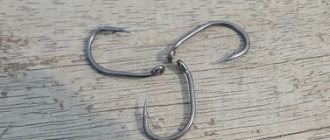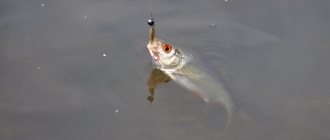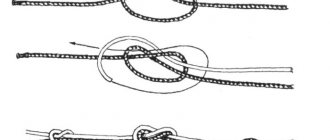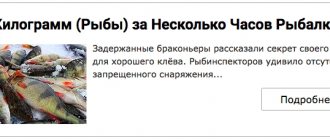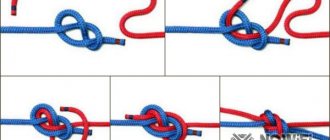Every fisherman should be able to tie knots; fishing is not complete without it. There are a lot of such knots in the arsenal of an experienced fisherman, there are the most favorite and most reliable ones, it all depends on what they should be used for.
When fishing, you have to tie together fishing lines of different and equal thicknesses, braided and monofilament, leashes and the main fishing line. The Albright node is fully suitable for all these operations. At the same time, it is distinguished by its relative simplicity of knitting and is easy to remember.
What is a fishing knot and its types
A fishing knot is a manipulation of the fishing line, which allows it to be tied when it breaks or attaches additional structures. There are several main types of fishing knots:
- knots for tying hooks;
- wobbler units;
- knots for tying fishing lines;
- locking units;
- knots for side leash.
All of them perform certain functions and differ in the degree of reliability when tensioning the fishing line while playing fish.
Expert opinion
Knipovich Nikolai Mikhailovich
Zoologist, hydrobiologist. I am interested in fishing at a professional level.
Important! It is necessary to observe the proportions of the size of the knot and its strength. A massive knot, of course, will be stronger and more reliable, but in the water it will be more noticeable; a very large structure will simply scare away the fish.
Fishing knots are in many ways similar to sea knots; sometimes they simply repeat each other.
What is necessary to avoid missing large fish?
When using this type of knot you need to be careful, because there is a possibility of missing the fish. But if you are careful in this or that situation, then you will not miss the prey. To do this, you must follow a number of rules:
- If after a bite there is no hook, then you should not touch the reel under any pretext. Also, you can't reel it in.
- Also, if all the prerequisites for the fish are present, you should not hook with maximum force, because you can tear the lips of your prey. This is justified by the fact that there are fish with soft lips that tear even with the slightest movement towards resistance.
- It is necessary to hook the fish on time.
This is interesting: Legal basics of first aid and some tips
History of the creation of the Albright node
It is believed that this knot was invented by the American fisherman Jimmy Albright , and was originally used in fly fishing, but later the versatility and compactness of this connection made it almost universal.
However, Finnish fishing enthusiasts, not without reason, claim that it was not on the territory of their country that similar connecting structures have been used since ancient times, only in a simplified form.
During its use, the Albright knot was modified several times, and is now used in float, spinning and bottom fishing, especially when tying lines of different diameters or attaching small hooks to a leash.
The reliability of such a connection is close to 100%.
How is this type of knot tied?
The Albright knot is quite interesting, but it is easy to tie. Before you do this, you need to know a few facts about it:
- Before tying anything with this knot, you need to select two types of fishing line. But they must differ by two sizes.
- Next, you need to fold one or another fishing line in half. It must extend ten centimeters from a certain bend.
- Next you need to thread the resulting loop and wrap the end around it about six times. If your fishing line is thick, then you need to do this several times more.
- After you complete these procedures, you need to thread the same loop several times with a thin fishing line.
- The last stage is tightening the loop.
The Double Albright fishing hub has a competitor in its area. But these units can compete only in a fluorocarbon connection or in connection with a fishing line. It is also worth noting that Albright’s competitor, the Carrot knot, can only be used when fishing with a spinning rod.
Advantages and disadvantages
The undoubted advantages of this connection include:
- knitting speed; despite the fact that this knot is one of the strongest, it is knitted quickly and easily; this is especially valuable when replacing gear components or breaks;
- sliding through the passage rings also occurs almost without difficulty; this is achieved by the compactness of the knot even on thick fishing lines;
- very high reliability; at the same time, the node retains it for a very long time.
The disadvantages of the fishing connection include errors in absolutely all nodes:
- Dirt accumulates in the water on the unit, which should be cleaned periodically;
- if the guides on the rod are too frequent and small, certain difficulties may arise when casting.
Advice from professionals
Fishing experts give a lot of advice on using and installing this unit. For example, in order to tie this or that braid, it is better to use a thick type of fishing line. This is justified by the fact that a thin one can get burned on the braid and tear, which cannot be said about a thick one.
Before you knit this knot, you should wet it. This will allow you to avoid any type of burning. But there are also exceptions to this rule. This is a so-called braided line and cannot be wetted.
If the fishing line is very different in size from its partner, then you should not use them. The knot in this case will turn out to be quite large, which will not be justified. Here it will be inconvenient, since the casting of the bait will be weak.
Only a thin type of fishing line needs to be wrapped around a particular loop. You need to understand that in this case the entire load will go only to the thick one, which will allow you to prevent various situations.
How to choose when to use and when not to use
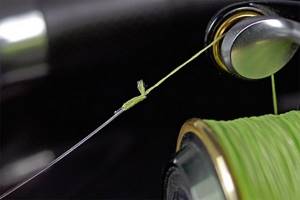
There are several options for using this node, which have already become traditional:
- when attaching the shock leader to the fishing line;
- when tying homogeneous fishing line materials at break;
- when it is necessary to connect dissimilar materials: fluorocarbon and fishing line, cord and fishing line;
- when you need to firmly tie fishing lines, especially of different diameters.
However, it should be borne in mind that if the diameter of one fishing line is more than 2 times greater than the diameter of the other, the knot will turn out to be bulky and will scare away the fish .
In these cases, you should not use it; it is better to use another connection.
Using a knot for the so-called shock leader
A shock leader is a thick type of fishing line. This type of product is primarily used if the so-called forceful demand for bait is necessary. This line is twice as thick as standard. This is also great for preventing cuts from its thinness. Due to the fact that the bait is laid quite far, the Albright knot itself needs to be long and even.
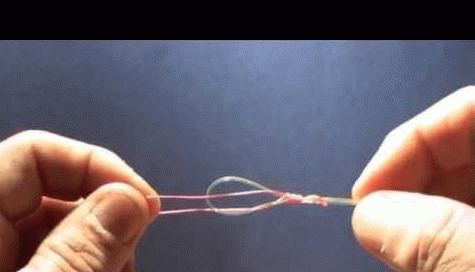
If you are fishing for carp, then this knot connects two types of fishing line, shock leader and thin. It also helps other analogues, because then they are not subject to any kind of friction at all.
When you create this knot, you need to trim the remaining ends to perfection. The remaining nuances directly depend on the thinking of the fish itself.
This is interesting: Under-barrel flashlight for a 12-gauge shotgun for hunting
Step by step instructions on how to knit
Standard
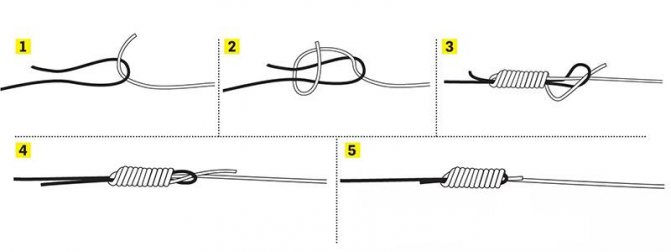
The step-by-step diagram of this knitting looks like this:
- A loop is made from the end of one line.
- The end of the second is threaded into this loop.
- It is brought to the base of the loop.
- Then the base is wrapped with this end several times, 5-10 turns are considered optimal; it all depends on the thickness of the material.
- The end is threaded through the loop and tightened.
As you can see, the procedure is not very complicated, but if you reduce the number of turns, the strength of the knot will be less.
Expert opinion
Knipovich Nikolai Mikhailovich
Zoologist, hydrobiologist. I am interested in fishing at a professional level.
Important! Before final tightening of the knot, it is recommended to moisten the fishing line with cold water, otherwise, when tensioned, it will heat up and become deformed.
Improved

Improved Albright knot (also called Improved Albright Knot ) begin to knit in the same way.
A loop is made, the end of one of the fishing lines is threaded into this loop and wrapped around its base. But then several turns are made inside the loop itself, and only after that the knot is tightened. This method is increasingly used today when attaching a shock leader to the main fishing line.
Who needs to know how to tie this knot?
You should definitely know how to tie an Albright knot:
- Fans of carp fishing. The requirements for gear for carp have always been higher than the requirements for gear for any other white fish. It is the carp that most often, with an unexpected maneuver, breaks the leashes in the most vulnerable place - at the knot.
- Trophy hunters in feeder fishing and carp fishing. The shock leader will not be reliable enough if any other connection method is used in the rig.
- Fans of float fishing at long distances (Bolognese match fishing method), as well as spinning anglers who use heavy baits in their arsenal. In these fishing methods, if the equipment is unbalanced, it may overlap. Excessive load on the monofilament during casting leads to its damage and breaks. The theory requires a complete replacement of the main line. But you can splice the main line by tying it at the break point. The Albright node is ideally suited for these purposes.
Nodes similar to Albright
The node we are considering has many similar designs:
- "carrot"; is considered the most similar to Albright, has a high degree of reliability, but passes through the throughput rings a little worse;
- Leader knot; most often used when tying leashes;
- Double Uni knot; it is often used by those fishermen who go out for large pike;
- PR connection; The only drawback of this knot is that it has to be knitted using a special tool, if you do not use a simplified version.
Application
This knot is suitable in any situation where you need to splice two fishing lines together.
For example, when fishing with a spinning rod, this knot connects braid and thin fishing line. Thanks to this, the leash and fishing line are securely connected. In float fishing, the Albright is used as a swivel. The swivel makes it easier to rotate parts of the tackle and is an excellent assistant when casting far, as it allows the line to travel much further.
Micro swivels are used for sport fishing. And in regular fishing, a larger size is preferable; in some cases, the internal diameter of the ring can reach 2.5 millimeters. Thanks to this, changing leashes is easy, since the hook passes easily.
When using Albright, the tackle is less cumbersome. A small knot can even be closed with a pellet. This method is often used for sport fishing, as it provides balance and sensitivity to the gear.
More often, Albright is used to connect fly fishing line to extension cord. In general, it is suitable for splicing absolutely any fishing line or rope.
As previously mentioned, Albright is used almost everywhere where it comes to how to efficiently tie two fishing lines. Let's talk about spinning fishing. Here the Albright serves as a link between the main line and the leader. As a rule, in spinning fishing, Albright ties together thin line and braid.
It should be noted that the main line should be thicker, since it is braided and can burn thin line, but this does not happen with an increase in diameter.
In the case of a shock leader, which is used very rarely in spinning rods, this does not happen, since the shock leader itself is much thicker in diameter than the main fishing line. When tying a knot, it is very important to wet both lines, otherwise one may burn out. Braided fishing line does not burn through, but ordinary monofilament is subject to this feature.
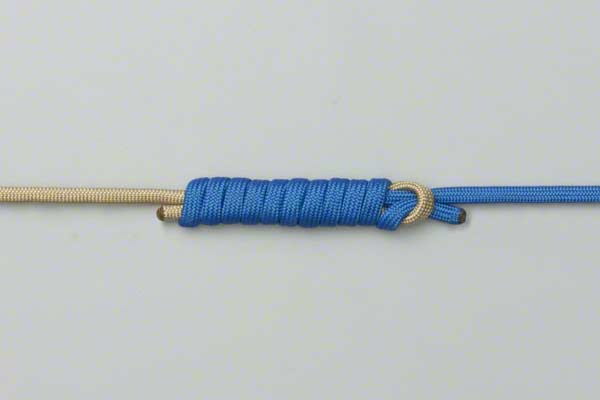
It is very important when tying a knot to remember the combination of fishing lines. You should not allow the two fishing lines to be very different from each other in size, otherwise you will end up with a bulky knot that will whistle in the guides, as a result of which the cast will be much closer, and it will not be comfortable to fish with a whistling knot.
Typically, an “Albright” is a knot that connects fishing lines that differ twice in size. This ratio will prevent the knot from becoming too large.
The use of Albright in float fishing is no longer uncommon. Usually in this case Albright is used as a swivel. With a swivel, the tackle becomes cumbersome, but with an Albright, you get a small and neat knot, and if desired, you can completely close it with a pellet.
Typically, this method is used by athletes when sensitivity and balance of gear is required, so I advise novice fishermen to take note, because you can avoid the use of swivels and simply tie an Albright.
Now let's talk about carp fishing. Here you can’t do without Albright, since it connects the main line and the shock leader. Since the rings of a carp rod are large, large knots slip without much friction and do not whistle.
When carp are cautious, they avoid using thick braid and here you can be guided by the same principle as in spinning fishing.
It’s better not to go too small with the diameter of the shock leader, and even if we take this feature into account. that the shock leader is a thicker branch line, which allows you to avoid cuts during power casting, then the main line will differ by almost half, and sometimes less.
Power casting means that the bait is sent a considerable distance from the shore. Thus, the knot simply must be even and smooth. In order for the knot to turn out smooth, it must be tied correctly and efficiently, and besides, all the protruding ends of the main line and the shock leader must be cut to fit the face. Now let's talk about how to tie Albright correctly.


